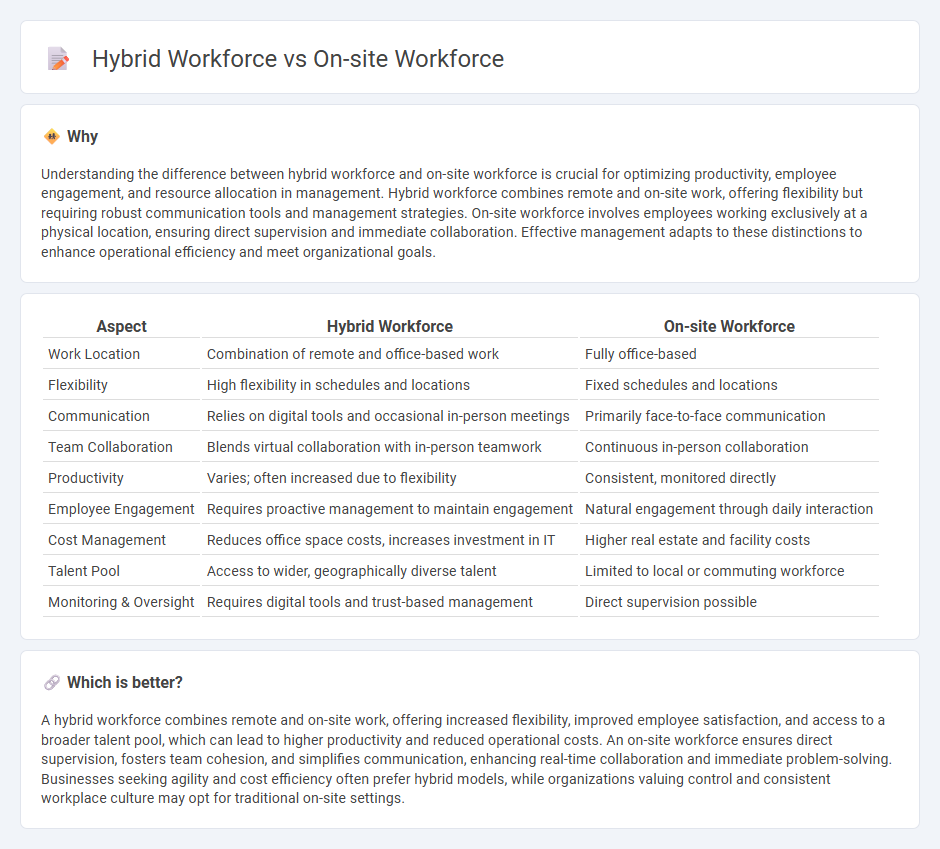
The hybrid workforce combines remote and on-site work, offering flexibility that boosts employee productivity and satisfaction while reducing operational costs. On-site workforce models emphasize direct supervision, immediate collaboration, and a unified company culture that can enhance team cohesion and quick decision-making. Explore deeper insights into optimizing management strategies for both hybrid and on-site workforces.
Why it is important
Understanding the difference between hybrid workforce and on-site workforce is crucial for optimizing productivity, employee engagement, and resource allocation in management. Hybrid workforce combines remote and on-site work, offering flexibility but requiring robust communication tools and management strategies. On-site workforce involves employees working exclusively at a physical location, ensuring direct supervision and immediate collaboration. Effective management adapts to these distinctions to enhance operational efficiency and meet organizational goals.
Comparison Table
| Aspect | Hybrid Workforce | On-site Workforce |
|---|---|---|
| Work Location | Combination of remote and office-based work | Fully office-based |
| Flexibility | High flexibility in schedules and locations | Fixed schedules and locations |
| Communication | Relies on digital tools and occasional in-person meetings | Primarily face-to-face communication |
| Team Collaboration | Blends virtual collaboration with in-person teamwork | Continuous in-person collaboration |
| Productivity | Varies; often increased due to flexibility | Consistent, monitored directly |
| Employee Engagement | Requires proactive management to maintain engagement | Natural engagement through daily interaction |
| Cost Management | Reduces office space costs, increases investment in IT | Higher real estate and facility costs |
| Talent Pool | Access to wider, geographically diverse talent | Limited to local or commuting workforce |
| Monitoring & Oversight | Requires digital tools and trust-based management | Direct supervision possible |
Which is better?
A hybrid workforce combines remote and on-site work, offering increased flexibility, improved employee satisfaction, and access to a broader talent pool, which can lead to higher productivity and reduced operational costs. An on-site workforce ensures direct supervision, fosters team cohesion, and simplifies communication, enhancing real-time collaboration and immediate problem-solving. Businesses seeking agility and cost efficiency often prefer hybrid models, while organizations valuing control and consistent workplace culture may opt for traditional on-site settings.
Connection
Hybrid workforce models integrate remote and on-site employees, fostering flexible collaboration and real-time communication between both groups. On-site workforce presence supports direct supervision, immediate problem-solving, and strengthens corporate culture, enhancing overall team cohesion. Effective management balances technology-driven coordination with face-to-face interactions to optimize productivity and employee engagement across hybrid and on-site teams.
Key Terms
Productivity
On-site workforce often benefits from direct supervision and immediate collaboration, leading to increased accountability and structured workflows that enhance productivity. Hybrid workforce models provide flexibility, reduce commute times, and leverage digital tools that can boost individual efficiency and work-life balance. Explore detailed strategies to optimize productivity across both on-site and hybrid work environments.
Collaboration
On-site workforce environments foster real-time collaboration through face-to-face interactions, promoting immediate feedback and cohesive teamwork. Hybrid workforce models leverage digital tools to facilitate communication across remote and in-office employees, balancing flexibility with connectivity. Explore strategies to enhance collaboration efficiency in both workforce setups.
Flexibility
An on-site workforce provides structured environments promoting direct supervision and immediate collaboration, which suits roles requiring hands-on tasks and rapid decision-making. Hybrid workforces offer greater flexibility by combining remote and in-office work, improving employee satisfaction and work-life balance while maintaining essential team interactions. Explore how balancing on-site and hybrid models can optimize productivity and flexibility in your organization.
Source and External Links
On-site Workforce Management - Kelly Services provides on-site workforce management solutions to help organizations manage temporary and high-volume workforces efficiently.
Onsite vs Remote vs Hybrid Workers - This blog post compares the pros and cons of onsite, remote, and hybrid work models, highlighting their advantages and disadvantages.
Onsite Job: Everything You Need To Know - This article discusses the benefits and applications of onsite work, including its role in innovation and collaboration.
 dowidth.com
dowidth.com